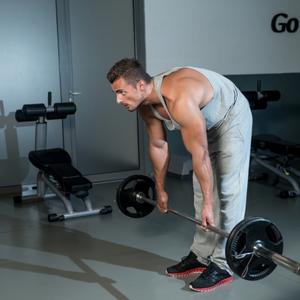Deadlift for beginners was and still is one of the controversial topics among teenagers or who have just started weightlifting.
Deadlifting is one of the oldest and most intense exercises for building muscle and strength. However, it’s also one of the most technical and potentially dangerous exercises, especially for beginners.
In this article, I will discuss with you the proper techniques for deadlifting and common mistakes to avoid.
Table of Contents

Understanding the Deadlift
The deadlift is a powerful compound exercise that works on multiple muscle groups simultaneously; more than 11 muscles are engaged while performing the deadlift.
But the most targeted ones are the glutes, hamstrings, lower back, and upper back.
The movement involves picking up a barbell from the ground, with the weight resting on the floor, and lifting it to a standing position.
The exercise can be performed with a standard barbell or with dumbbells.
There are several variations and types of deadlifts, including the conventional deadlift, sumo deadlift, and trap bar deadlift. Each way targets slightly different muscle groups and requires a slightly different technique.
In this article, we will go deep into the conventional deadlift, covering everything you need to know to perform this exercise correctly and effectively.
Proper Deadlifting Technique

Before you start deadlifting, it’s essential to understand the proper technique. Here’s a step-by-step guide to performing the conventional deadlift:
- Stand with your feet hip-width apart, with your toes pointing forward.
- Place your hands on the barbell, gripping it with an overhand grip (palms facing down). Your hands should be just outside of your legs.
- Bend your knees and hips, keeping your back straight, and lower your body until you are in a crouched position with your hips lower than your shoulders. This is the starting position.
- Drive through your heels, straightening your legs and hips, and lift the barbell off the ground. Keep your back straight and shoulders back as you lift.
- Once the barbell is at hip level, pause for a moment and squeeze your glutes.
- Lower the barbell back to the starting position, keeping your back straight and hips low.
It’s essential to keep your back straight throughout the movement and to avoid rounding your lower back. This can put you at risk of injury.
Dont also forget the chest muscle, especially bench press; learn how to perform the correct way to bench press
Common Deadlifting Mistakes

While the deadlift is a highly effective exercise, it can also be dangerous if performed incorrectly. Here are some common mistakes to avoid:
- Rounding your lower back.
- Lifting with your back.
- Not keeping your hips low.
- Lifting with too much weight: It’s essential to start with a weight that you can comfortably lift with proper technique.
- Not keeping your shoulders back.
Frequent questions about deadlift for beginners
What’s the ideal weight to start deadlifting?
Start with the lightest weight, and focus on the proper technique first.
Is watching videos about deadlift for beginners enough to start?
No, not even this article; you must have someone expert or a coach see your technique and approve it.
Is it necessary to wear the deadlift belt always while deadlifting?
It is highly recommended since a deadlift exercise could be dangerous if it didn’t perform correctly.
Tips for Deadlifting Success
Here are some tips for getting the most out of your deadlifting:
- Warm up properly: Before deadlifting, it’s essential to warm up your muscles with light cardio and stretching routine.
- Use proper form: Make sure to use proper form and technique when deadlifting, as outlined in this article.
- Start with a lightweight: It’s essential to start with a weight that you can comfortably lift with proper technique.
- Progress slowly: As you get stronger, gradually increase the weight you’re lifting.
- Be aware of your breathing: Take a deep breath in before lifting and exhale as you lift the bar.
- Engage your core: Tighten your abdominal muscles before lifting to help support your lower back.
- Avoid overtraining: Make sure to give your body adequate rest and recovery time between deadlifting sessions.
- Practice proper posture: Keep your shoulders back and your chest up throughout the movement.
- Use proper shoes: Make sure to wear shoes with a flat sole and good grip to ensure stability while lifting.
- Get a spotter: If you’re lifting heavy weights, it’s a good idea to have a spotter to help you in case you need assistance.
If you are an overweight person and have mastered the technique, kindly check this article as well: Fat Burning Workouts: 2 Proven Effective Ways to Burn Fat
Wrapping Up
Deadlifting is an excellent exercise for building muscle and strength, but it’s crucial to approach it with proper technique and form.
By following my guidelines and advice, you can avoid common mistakes and ensure you get the most out of your deadlifting routine.
Always keep in your mind to warm up properly; start with a lightweight; take your time learning the proper technique, then you will see the progress slowly.
And focus on your breathing and core engagement. Additionally, you must avoid overtraining, and being at the gym for hours wastes time and energy; wear flat shoes or take off your shoes.
With proper form, progressive overload, and consistency, you will see the results you aimed for and the many benefits of deadlifting.

